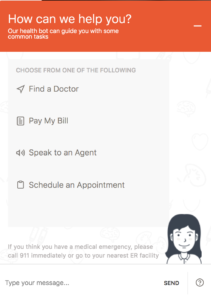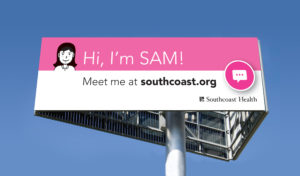What do visitors to your website really want? That’s the million-dollar question—but until recently, we haven’t had a great way to answer it.
Healthcare organizations usually rely on web analytics to figure out how visitors engage with their sites. Metrics like search terms, page visits, clicks, and time spent on-site offer insights into visitors’ digital behavior, but they don’t give a full picture of the intent behind those actions.
That’s where conversation comes in. Whether you’re using chatbots or a voice interface, conversing with your users lets you better understand their motivations—and, ultimately, create better outcomes for you and your customers.
Voice and Chat on the Rise
In every corner of the digital world, people are flocking to conversational platforms to connect with friends, share information, and find answers to their questions. Both voice search and chat platforms have soared in popularity in the last few years. In fact, since 2015, the top four chat and messaging apps have drawn more users than the top four social media apps.
Today, over 60 million Americans use a voice-enabled virtual assistant equipped with Siri, Cortana, or Google Assistant at least once monthly to search for information or connect with a brand. Even more shocking (and a little distressing), Gartner predicts that by 2020, the average person will have more conversations with bots than with their spouse.
Opportunity for Healthcare
With the rise of consumerism, healthcare has quickly started to take its cues from industries and brands known for providing the best customer experiences. While retail has to lead the way in the implementation of chatbots to improve the buying experience, the opportunity for health systems is hard to ignore. Second only to online retail, a 2017 worldwide Statista survey revealed that 27% of respondents would prefer to have healthcare-related questions answered by AI chatbots or virtual assistants.
So why is healthcare so ripe for this emerging technology? Simply put, because healthcare is notorious for being confusing and oftentimes frustrating. From the moment a patient begins her journey there are hundreds of questions that need to be answered. And what better way to answer those questions than by using a technology that is available 24/7, instant to respond, and engaging?
Take visiting a hospital for instance. When you walk in, you’re greeted with signs, maps, maybe even arrows painted on the floor. Despite those navigational aids, you might still be tempted to ask the front desk staff to point you in the right direction.
Like hospitals, healthcare websites can be tough to navigate. Navigational tools try to direct visitors to the right information, but there’s often an overwhelming amount of content. Ultimately, a conversation can be the best way to understand what users are truly looking for.
Early Adoption
In September 2017, Atlanta’s Piedmont Healthcare went live with a chatbot on just a few pages of its website. Today, and over 45,000 conversations later, Piedmont now knows much more about what patients are looking for when they come to the site simply by asking visitors, “How can we help you?” Patients are searching for everything from physicians, specific contact phone numbers, insurances accepted, medical forms, and class registration to billing information. Often the answers to these questions are buried in the 10,000+ pages of the website, or they may not exist on the site at all.
 In addition to the obvious benefits of access, convenience, and engagement that a chatbot brings to a health system’s website, the analytics from conversations provide multiple light bulb moments for system executives. Matt Gove, Piedmont’s Chief Consumer Executive, says, “We always felt really good about our site. It was well designed, organized, and mostly easy to navigate. But when you expand from a five to 11 hospital health system in less than five years, there are going to be growing pains.”
In addition to the obvious benefits of access, convenience, and engagement that a chatbot brings to a health system’s website, the analytics from conversations provide multiple light bulb moments for system executives. Matt Gove, Piedmont’s Chief Consumer Executive, says, “We always felt really good about our site. It was well designed, organized, and mostly easy to navigate. But when you expand from a five to 11 hospital health system in less than five years, there are going to be growing pains.”
But can a computerized bot really tell you what a person is thinking any better than page views and clicks? The answer might surprise you.
The insights gained were eye-opening for Piedmont. “Before we introduced the chatbot, visitors were not finding what they were looking for, and bounce rates were extremely high,” Gove says. “As an organization focused on improving the complete patient experience, we need to understand the full picture. While helpful, Google Analytics simply couldn’t provide that. With an ‘always on’ chatbot, we are able to have those conversations across the digital experience and understand not just the sentiment, but also uncover incredible opportunities to improve the patient experience.”
Another early adopter, Southcoast Health in New Bedford, MA, quickly realized the benefits of using an AI-driven chat. With more than 10,000 conversations in just over six months, Southcoast’s chatbot, branded SAM, has already become an invaluable part of the website improvement and consumer analytics team.
“We immediately saw a strong engagement and actionable insights after going live with SAM on our site,” says Traci McNeil, Director of Marketing and Communications at Southcoast Health. “Being able to see the questions our patients are asking in real time and make quick adjustments has been a game changer.” Now boasting an accuracy rate comparable to Google Assistant, SAM has become a staple on the Southcoast Health website, with a 23% growth in engagement since going live.
Natural Language Processing and Intent
So how does all of this work? Chatbots and voice search both rely on a tool known as natural language processing (NLP) to understand a user’s intent. If a visitor says (or types) “How can I find my medical records?” or “Where do I see my test results?”, NLP breaks that down into words and phrases to understand the person’s intent—and direct them to the right login page.
Over time, the system creates a robust “intent library” that matches words and phrases to meanings and intentions. The benefits of that are twofold:
- Chatbot developers use the intent library to train chat platforms to better understand what visitors are looking for. Over time, the chatbot gets even better at answering users’ questions correctly and directing them to the right content, or even helping them schedule an appointment.
- By seeing what types of conversations are happening on chat, organizations learn more about their own sites. Are there gaps in content? Are some portions of the site confusing to visitors? Looking closely at user intent can help you improve and reorganize your content for a better digital patient experience, optimize digital campaigns for better targeting, and identify ways to improve patient access.
When you understand what your consumers truly need, you can provide the right content to answer their questions quickly and efficiently. That makes for a better digital patient experience. And when chatbots can handle more questions, human operators are free to deal with questions that require a human touch. That’s a win-win for patients and healthcare organizations alike.
Want to learn more? Attend the Healthcare Marketing & Physician Strategies Summit, May 21-23, 2019, where Brian Gresh will be speaking with Daniel Ruyter from Orlando Health.

Brian Gresh is the President of Loyal, an AI-driven healthcare technology company that partners with the nation’s leading health systems to provide solutions that promote patient loyalty through a smarter digital patient experience.


